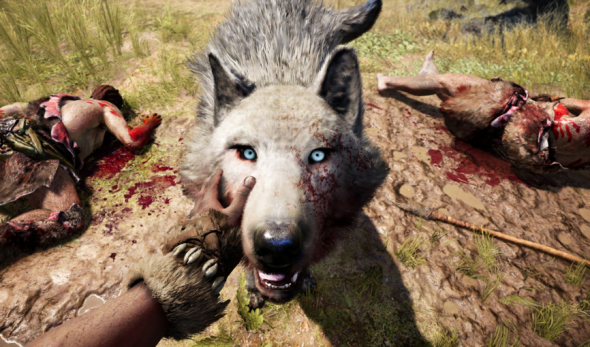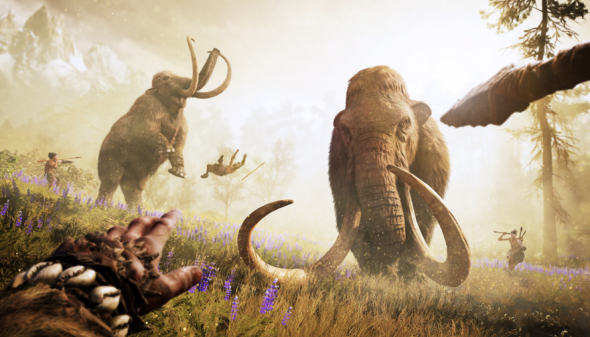Reviews
Far Cry Primal
April 8, 2016, Author: James Swinbanks
From the moment it was announced, Ubisoft’s decision to make Far Cry Primal was met with intrigue and more than a few questions: How well would a Far Cry game work without guns? Is fighting with stones and sharp sticks going to be as satisfying as with a flamethrower and grenades? Some of my friends thought it was a ‘brave’ move, and all I could ponder was the vast scope of great stories that could be told from that era of human life.
After 30-odd hours of skull-bashing and crouching in the reeds, I feel confident in saying that Far Cry Primal is not really brave, but it does put forward a big AAA take on primitive tribal life, all the while remaining true to the series’ recent direction.
As Takkar (or as his people call him, the Beast Master), it falls to you to explore the land of Oros and reunite your people, the Wenja tribe. Along the way you’ll take on other enemy tribes, hunt down and be hunted by animals and beasts, light giant bonfires and explore a vast and lush wilderness that is as arresting as it is threatening. It’s an inviting mix on the face of it, but ordinary melee combat, stale progression mechanics, a complete lack of co-operative multiplayer, and a narrative that lacks any kind of meaningful hooks make Far Cry Primal fade into history without making any significant impact.
Takkar starts out a relatively normal fellow, capable of using a small selection of simple weapons and abilities. It’s not until you start unlocking skills through story progression that you start to feel like a truly revered warrior. Skills vary from the usual doubling of items collected when scavenging, and raising maximum health, through to gaining the ability to chain together take downs. Some of these feel more useful than others, particularly in the early portions, though thankfully I never felt cornered into playing a certain way because of that.
Skill points are also relatively easy to come by, largely due to the hefty number of side-missions, many of which will interrupt what you’re doing and call for you to jump into action. The problem I have is that they’re more akin to random encounters, and it didn’t take long for me to get bored of being called away from what I was trying to do that I started skipping them altogether.
One of the more useful and interesting skills is when you gain access to the ‘Beast Tamer’ ability, which sees Takkar take on his predestined role as Beast Master. Once gained, Takkar is able to tame the more fearsome of the local fauna, beginning with dholes – hyena-like dogs – and wolves alike, then moving up to larger creatures like bears and sabretooth tigers. You can also learn the ability to ride your larger beasts – Oros is a big place, and there is usually a bit of walking around required, even with all the fast travel points unlocked. Having a giant beast walk and fight alongside you is by far the moment that Primal feels the strongest. Seeing your sabretooth leap on to the back of, then take down, a mammoth is a genuine jaw-dropper.

Gotta catch ’em all…
This beast taming business all comes about thanks to the drinking of a mix of sacrificial bloods, offered over by a village spiritualist/witch doctor. This leads to the now obligatory ‘tripping balls’ scene we’ve become accustomed to in previous Far Cry entries, which is actually pretty fun in its own right, if very short. There aren’t too many sequences that go out of their way to break up the monotony of the gameplay, which ends up hurting Primal in the longer run. I will add here that the inclusion of multiplayer co-op may have been the perfect solution to combat this monotony, but it’s been surprisingly excluded. I’m not sure how popular Far Cry multiplayer was in the past, but I remember the most fun I had with any of the previous games was with a friend, wreaking havoc the only way we know how.
I could go on, but there are actually a few things about Far Cry Primal that I did enjoy, so let’s talk about that for a while.
As one can expect from Ubisoft these days, Primal paints a gorgeous picture of a world before humanity had the chance to carve its initials into it. Oros is ripe with both flora and fauna. Giant trees scatter about the forest near the Wenja village, whilst down south is a more marshy wetland. North is more a wasteland, littered with snowy, frozen plains and mammoth graveyards. You can only run around in the North for so long before you freeze to death, unless you happen to have winter clothing or can find an open fire to warm yourself next to, that is. It’s a small but nice way to change up how you navigate one of the harsher climates in Oros.
It’s also the home of the Udam, one of the enemy tribes you face off against, and they are just as hardened as the land in which they inhabit. Their leader, Ull, is a beast of a fellow who’s cloaked in wolf furs and carrying one hell of a bad scar on his face. He is also one of the exceptionally better-looking character models in the game. Main characters in Primal feel rather varied, but the same can’t be said for the rank and file NPCs that run across the land, hunting and fighting on their own time. Despite appearing like clones of each other, at least they look the part. The costume design and set dressing that you see across the world really looks great.
Each tribe has a different way of life, and this is reflected heavily in their parts of the world. The camps and outposts of the Udam are often filled with the bodies of their victims, which have been left to rot like a half-eaten meal. Mammoth skulls are used as giant totems, and large, sharpened barricades of logs are left as protection from the giant beasts that roam the same parcel of land. The Izila are less messy, but just as bloodthirsty, with much of their land appearing similar to the Wenja – relatively lush and lively, but with many stone spires and lots of fire. They also make use of a particular type of blue plant that they use to paint themselves, making them easily identifiable. All of this shows lovely attention to detail from the art department, and is easily the most impressive aspect of Primal.

Primal at its best…
Another aspect I really appreciate is the use of subtitles throughout the entire experience. None of the characters in Primal speak English. Ubisoft hired a team of linguists to create a native dialect between each of the tribes, which is a really nice touch. It’s also a part I find slightly disappointing, but that has nothing to do with the language itself and more to do with how it’s presented. The English subtitles are all simplified, meaning a sentence like “Come with me, Brother, and we’ll teach them a lesson” becomes “Come with me. We teach lesson“.
It’s understandable that perhaps at the time this was the level of communication these characters used, but from the context of a story being told, it just leaves everything feeling a bit too simplistic for my tastes. With that being said, there are a small handful of genuinely touching sequences that help give these characters more depth than their “simplified” language lets on.
One of the big questions when Primal was announced was “How well can a Far Cry game play without guns?” and the answer is sadly underwhelming – it’s not bad, but not great. The thing is, throwing spears through an enemy’s face is disturbingly satisfying, as is nailing a few quick-burst head shots from your bow. You can also set many of your weapons on fire, meaning you can freely throw burning spears or clubs ’til your heart’s content, which takes advantage of the series’ now famous fire propagation mechanics. When things get up close and personal, though, the combat loses its flow, becoming a flailing melee of screen shake and motion blur. For that reason, I found myself trying to resort to ranged combat wherever possible, which is not always a possibility. It led to more than a few frustrated sighs.
Primitive?
I think the thing I’m finding the hardest to reconcile about Far Cry Primal is just where it sits in terms of its place in relation to others. It should feel unique – I mean there aren’t many other games that try to take on such an unknown time in history. There was a real chance to make something that stood out heavily from the crowd, and at first glance it almost gets there. The look of Primal hits the nail on the head, but everything else feels so run-of-mill. We’ve done all of this before, and if you’ve played any of the Far Cry games since FC3, then chances are you’ll already know what I’m talking about.
I mean, things like spending most of your time crafting things from the hides of the animals you kill, making food to heal yourself and your beast, and collecting things with which to build your village sound like they should be fun, but it’s all broken down into such easily digestible and understandable mechanics that they lack any substance. Every exercise feels by-the-numbers. The moment-to-moment ‘hunter-gatherer’ experience wore thinly on me so much faster than I wanted, and thus so did my urge to keep playing.
Ultimately, I feel like using the Far Cry template for Primal held it back from becoming something truly special. I’m sure some people will disagree. It is still a Far Cry game, and those have been very popular games that sold quite well, but when you take a swing for the fences, which Primal‘s concept arguably is, it feels like a weird choice to not swing as hard as you can. By making a game that essentially relies on mechanics that have felt unchanged for a few years now, it ends up being more a swing-and-miss than an easy six.
Don’t get me wrong; I don’t think Far Cry Primal is a bad game, because it’s not. It not only looks amazing, but it’s technically sound, which is a lot to be said nowadays. It also has some genuinely fun and touching moments, but they are delivered so awkwardly and haphazardly that they don’t really resonate any further than in that moment. It’s here that Far Cry Primal loses me, and goes from being an incredibly engaging experience to just another game that uses a tried-and-tested formula from top to bottom. As a result, it’s one I think will quite quickly fade from memory.
Platforms: PC, PS4, Xbox One | Tagged far cry, Far Cry Primal, Mammoth, Primal, Sabretooth, Takkar, tribes



